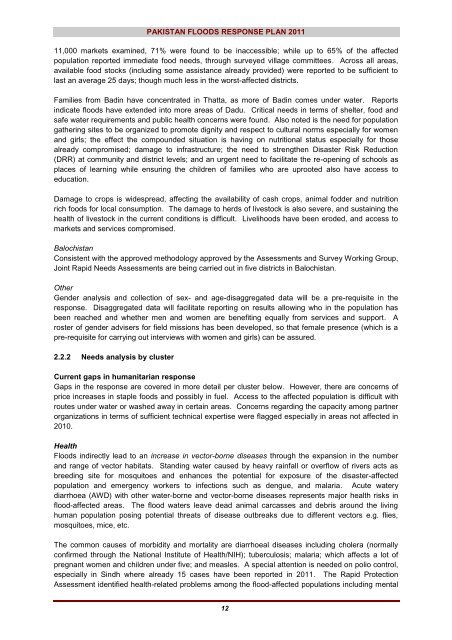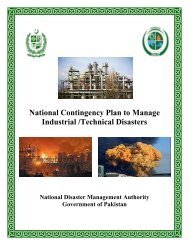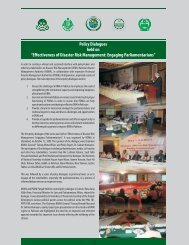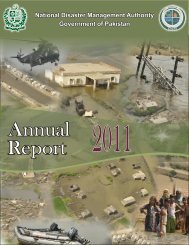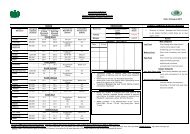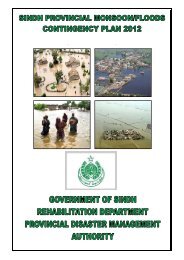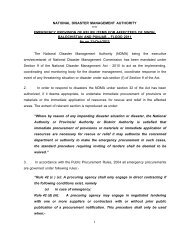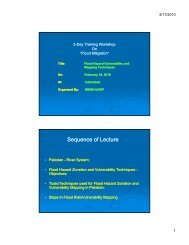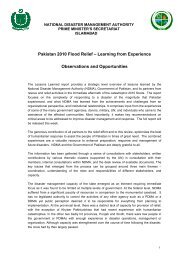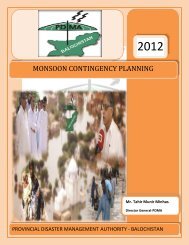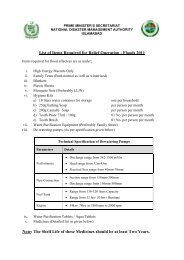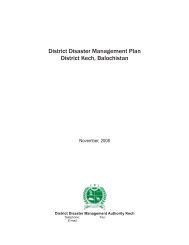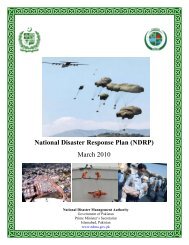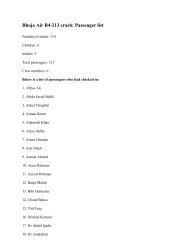Pakistan Floods 2011 - Humanitarian Response
Pakistan Floods 2011 - Humanitarian Response
Pakistan Floods 2011 - Humanitarian Response
- No tags were found...
You also want an ePaper? Increase the reach of your titles
YUMPU automatically turns print PDFs into web optimized ePapers that Google loves.
PAKISTAN FLOODS RESPONSE PLAN <strong>2011</strong>11,000 markets examined, 71% were found to be inaccessible; while up to 65% of the affectedpopulation reported immediate food needs, through surveyed village committees. Across all areas,available food stocks (including some assistance already provided) were reported to be sufficient tolast an average 25 days; though much less in the worst-affected districts.Families from Badin have concentrated in Thatta, as more of Badin comes under water. Reportsindicate floods have extended into more areas of Dadu. Critical needs in terms of shelter, food andsafe water requirements and public health concerns were found. Also noted is the need for populationgathering sites to be organized to promote dignity and respect to cultural norms especially for womenand girls; the effect the compounded situation is having on nutritional status especially for thosealready compromised; damage to infrastructure; the need to strengthen Disaster Risk Reduction(DRR) at community and district levels; and an urgent need to facilitate the re-opening of schools asplaces of learning while ensuring the children of families who are uprooted also have access toeducation.Damage to crops is widespread, affecting the availability of cash crops, animal fodder and nutritionrich foods for local consumption. The damage to herds of livestock is also severe, and sustaining thehealth of livestock in the current conditions is difficult. Livelihoods have been eroded, and access tomarkets and services compromised.BalochistanConsistent with the approved methodology approved by the Assessments and Survey Working Group,Joint Rapid Needs Assessments are being carried out in five districts in Balochistan.OtherGender analysis and collection of sex- and age-disaggregated data will be a pre-requisite in theresponse. Disaggregated data will facilitate reporting on results allowing who in the population hasbeen reached and whether men and women are benefiting equally from services and support. Aroster of gender advisers for field missions has been developed, so that female presence (which is apre-requisite for carrying out interviews with women and girls) can be assured.2.2.2 Needs analysis by clusterCurrent gaps in humanitarian responseGaps in the response are covered in more detail per cluster below. However, there are concerns ofprice increases in staple foods and possibly in fuel. Access to the affected population is difficult withroutes under water or washed away in certain areas. Concerns regarding the capacity among partnerorganizations in terms of sufficient technical expertise were flagged especially in areas not affected in2010.Health<strong>Floods</strong> indirectly lead to an increase in vector-borne diseases through the expansion in the numberand range of vector habitats. Standing water caused by heavy rainfall or overflow of rivers acts asbreeding site for mosquitoes and enhances the potential for exposure of the disaster-affectedpopulation and emergency workers to infections such as dengue, and malaria. Acute waterydiarrhoea (AWD) with other water-borne and vector-borne diseases represents major health risks inflood-affected areas. The flood waters leave dead animal carcasses and debris around the livinghuman population posing potential threats of disease outbreaks due to different vectors e.g. flies,mosquitoes, mice, etc.The common causes of morbidity and mortality are diarrhoeal diseases including cholera (normallyconfirmed through the National Institute of Health/NIH); tuberculosis; malaria; which affects a lot ofpregnant women and children under five; and measles. A special attention is needed on polio control,especially in Sindh where already 15 cases have been reported in <strong>2011</strong>. The Rapid ProtectionAssessment identified health-related problems among the flood-affected populations including mental12


